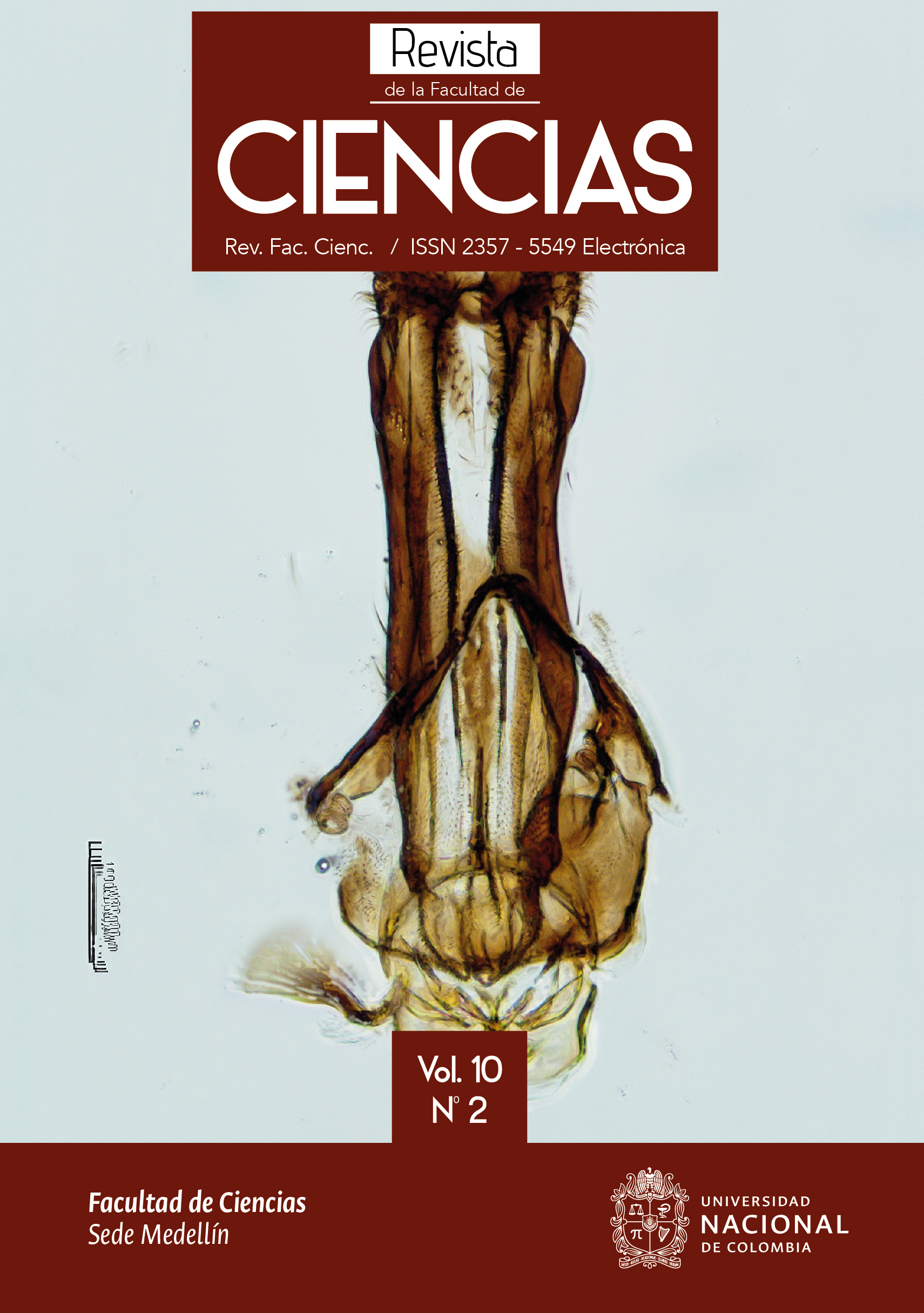CARACTERIZACIÓN DE LA CELULOSA PROVENIENTE DEL LODO PAPELERO Y SU ESTERIFICACIÓN
CHARACTERIZATION OF CELLULOSE FROM PAPER SLUDGE AND ITS ESTERIFICATION
DOI:
https://doi.org/10.15446/rev.fac.cienc.v10n2.94003Palabras clave:
celulosa, esterificación, lodo, acetato, papelero (es)Cellulose, esterification, sludge, acetate, papermaker (en)
Descargas
El tratamiento de efluentes de la industria de papel suave, genera un residuo denominado “lodo”, el cual es una mezcla de caolín y de fibras de celulosa. Debido a la importancia tanto biológica como comercial que este carbohidrato posee, se realizó la separación de la celulosa del lodo papelero para su caracterización y su modificación por una reacción de esterificación, encontrándose que el porcentaje másico presente de celulosa en el lodo papelero fue de 33% (m/m), lo cual hace factible su obtención a partir de este residuo orgánico, en el análisis semicuantitavo de la superficie se encontró la presencia de cloruro y es producto del método que se usó para la separación de la celulosa, en el cual se usó hipoclorito de sodio. La celulosa obtenida fue esterificada, obteniéndose el acetato de celulosa (monoester) por el análisis de FTIR.
The treatment of effluents in the soft tissue paper industry generates a residue known as “mud”, which consists in a mixture of kaolin and cellulose fibers. Due to the biological and commercial importance this carbohydrate possess, the paper mud was separated for its characterization and modification through an esterification reaction, finding that the cellulose mass percentage in the paper mud was 33% (m/m), which means the obtention of this organic residue is viable; In the semiquantitative analysis of the surface by SEM-EDX, the presence of chloride was found due to the method used to obtain it, in which sodium hypochlorite was used. An esterification reaction was carried out on the cellulose, obtaining the cellulose acetate (monoester), which was verified by the FTIR and for its solubility in dichloromethane.
Referencias
Abduk, H. Davoudpour, Y. Saurabh, C. Hossain, M. Adnan, A. Dungani, R. Paridah, M. Sarker, M. Fazita, M. & Syakir, M. (2016), A review on nanocellulosic fibres as new material for sustainable packaging: Process and applications. Renew. Sustain. Energy Rev. 64, 823–836 DOI: https://doi.org/10.1016/j.rser.2016.06.072
Adebajo, O. & Frosto, R. (2004), Acetylation of raw cotton for oil spill cleanup applicatiin: an FTIR and 13C MAS NMR Spectrocopic Investigation. Spectrochimica Acta Part A, 60, 2314-2321. DOI: https://doi.org/10.1016/j.saa.2003.12.005
Bolin, J. Peixin, T. Kelu, Y. & Gang S. (2015), Catalytic actions of alkaline salts in reactions between 1,2,3,4-butanetetracarboxylic acid and cellulose: II. Esterification. Carbohydrate Polymers, 132, 228-236 DOI: https://doi.org/10.1016/j.carbpol.2015.06.070
Carreño, S. & Murcia L., (2005), Obtención de acetato de celulosa a partir de residuos celulósicos postconsumo. Universidad Industrial de Santander. Bucaramanga, Colombia. p. 8-20, 25, 34-35, 39-43, 101-102.
Chen, Y. Bao, Y. Huang, Z. & Weng, Z. (2007), Synthesis and characterization of cellulose acetate propionate. J. Cell. Sci. Technol, 15 (2), 18–21.
Deng, Z. Leng, Y. & Jiang, C. (2008), Research on synthesis of cellulose acetate butyate. Chem. Res. Appl, 20, 418–421.
Gallardo, F. Bravo, C. Briceño, G. & Diez, M. (2010) Use of sludge from kraft mill wastewater treatment as improver of volcanic soils: effect on soil biological parameters. Revista de la Ciencia del Suelo y Nutrición Vegetal, 10, 48–61 DOI: https://doi.org/10.4067/S0718-27912010000100006
Gilbril, M. Lekha, P. Andrew, J. Sithole, B. Tesfaye, T. & Ramjugernath, D. (2018) Beneficiation of pulp and paper mill sludge: production and characterization of funtionalised crystalline nanocellulose. Clean Technologies and Environmental Policy, 20,1835–1845 DOI: https://doi.org/10.1007/s10098-018-1578-3
Habibi, Y. Lucia, L. & Rojas, O. (2010), Cellulose nanocrystals: Chemistry, self-Assembly and Applications. Chem. Rev. 110, 3479-3500. DOI: https://doi.org/10.1021/cr900339w
Huang, K. Wang, B. Cao, Y. Li, H. Wang, J. Lin, W. Mu, C. & Liao, D. (2011), Homogeneous Preparation of Cellulose Acetate Propionate (CAP) and Cellulose Acetate Butyrate (CAB) from Sugarcane Bagasse Cellulose in Ionic Liquid, J. Agric. Food Chem, 59, 5376–5381. DOI: https://doi.org/10.1021/jf104881f
Isogai, A. & Atalla, R. (1991), Amorphous celluloses stable in aqueous media: Regeneration from SO2–amine solvent systems. nd graft copolymersas blocks for functional materials. Journal of Polymer Science Part A: Polymer Chemistry, 29(1), 113–119. DOI: https://doi.org/10.1002/pola.1991.080290113
Kang, H. Liu, R Xu, & Huang, Y. (2012), Cellulose derivatives and graft copolymersas blocks for functional materials. Polym Int, 62, 338-394. DOI: https://doi.org/10.1002/pi.4455
Klemm D. Philipp, B. Heinze, T. Heinze, U. & Wagenknecht, W. (1998). Comprehensive Cellulose Chemistry: Fundamentals and Analytical Methods, Wiley-VCH, Weinheim. Vol 1. p 150. DOI: https://doi.org/10.1002/3527601929
Klemm, D. Heublein, B. Fink, H. & Bohn, A. (2005), Cellulose: fascinating biopolymer and sustainable raw material. Angew. Chem. Int. Ed. 44, 3358–3393 DOI: https://doi.org/10.1002/anie.200460587
Kondo, T. (1997). La relación entre los enlaces de hidrógeno intramoleculares y ciertas propiedades físicas de derivados de celulosa sustituidos regioselectivamente. Jornada de ciencia de polímeros. Parte B. Vol. 35. N° 4. p. 717-723.
Lekha, P. Andrew, J. Gibril, M. & Sithole, B. (2017). Pulp and Paper mill sludge: a potential resource for producing high-value products. TAPPSA 1,16–19
Lima, M. & Borsali, R. (2004), Rodlike cellulose microcrystals: structure, properties, and applications. Macromol. Rapid Commun, 25, 771-787. DOI: https://doi.org/10.1002/marc.200300268
Liu, Y. Ahmed, S. Sameen, D. Wang, Y. Lu, R. Dai, J. Li S. & Qin, W. (2021)., A review of cellulose and its derivatives in biopolymer-based for food packaging application. Trends in Food Science Technology, 112, 532-546. DOI: https://doi.org/10.1016/j.tifs.2021.04.016
López, M. & Arroyo M. (2003). Fibras naturales como refuerzos de matrices poliméricas. Revista de plásticos modernos: Ciencias y Tecnología de Polímeros, 564, 594-600.
Madsen, B. & Gamstedt, E. (2013), Wood versus plant fibers: Similarities and differences in composite applications. Adv. Mater. Sci. Eng. 2013. DOI: https://doi.org/10.1155/2013/564346
Monte, M. Fuente, E. Blanco, A. & Negro, C. (2009), Waste management from pulp and paper production in the European Union. Waste Manag, 29, 293–308. DOI: https://doi.org/10.1016/j.wasman.2008.02.002
Morán, J. (2008). Extracción de celulosa y obtención de nanocelulosa a partir de fibra sisal – caracterización. Universidad Nacional de Mar del Plata. Mar del Plata, Argentina. p. 1.
Ochoa de Alda JAG. (2008), Feasibility of recycling pulp and paper mill sludge in the paper and board industries. Resour Conserv Recycl, 52, 965–972. DOI: https://doi.org/10.1016/j.resconrec.2008.02.005
Sebe, G. Ham-Pichavant,F. Ibarboure, E. Koffi, A. & Tingaut, P. (2013), Supramolecular Structure Characterization of Cellulose II Nanowhiskers Produced by Acid Hydrolysis of Cellulose I Substrates, Biomacromolecules, 13, 570−578 DOI: https://doi.org/10.1021/bm201777j
Takeuchi, S. & Takasu, A. (2019), Facile rare-earth triflate-catalyzed esterification of cellulose by carboxylic anhydrides under solvent-free conditions, Polymer, 84, 12196. DOI: https://doi.org/10.1016/j.polymer.2019.121916
Tayeb, H. Amini, E; Ghasemi, S. & Tajvidi, M. (2018), Cellulose nanomaterials—Binding properties and applications: A review. Molecules, 23, 2684. DOI: https://doi.org/10.3390/molecules23102684
Ummartyotin, S. & Manuspiya, H. (2015), A critical review on cellulose: From fundamental to an approach on sensor technology, Renew. Sustain. Energy Rev. 41, 402-412. DOI: https://doi.org/10.1016/j.rser.2014.08.050
Wertz, J. Mercier, J. & Bédué, O. 2010, Celullose Science and Technology. First edition. Editorial EPFL Press. Italy. p. 24 DOI: https://doi.org/10.1201/b16496
Woodins C., 2003. Encyclopedia of Polymer Science and Technology–Cellulose Fibers, Regenerated, John Wiley & Sons, Inc. p 100. DOI: https://doi.org/10.1002/0471440264.pst046
Youssef, M. Kamel, S. El-Sakhawy, M. & El Samahy M. (2012), Structural and electrical properties of paper-polyaniline composite. Carbohydr Polym, 90,1003–1007. DOI: https://doi.org/10.1016/j.carbpol.2012.06.034
Zhang, Y. & Lynd, L. (2004). Toward an aggregated understanding of enzymatic hydrolysis of cellulose: noncomplexed cellulose system. Biotechnol. Bioeng. 88, 797–824. DOI: https://doi.org/10.1002/bit.20282
Cómo citar
APA
ACM
ACS
ABNT
Chicago
Harvard
IEEE
MLA
Turabian
Vancouver
Descargar cita
CrossRef Cited-by
1. Roxanna Mercedes Zambrano Muñoz, Denisse Margoth Zambrano Muñoz, Karol Revilla Escobar, Jhonnatan Aldas Morejon, Marcos Alberto Avilés Miño. (2025). Obtención de celulosa de residuos agrícolas de tres variedades de plátano (Musa acuminata Red dacca, Musa acuminata y Musa paradisiaca) para fines agroindustriales.. Revista Amazónica. Ciencia y Tecnología, 10(1), p.20. https://doi.org/10.59410/RACYT-v10n01ep02-0166.
Dimensions
PlumX
Visitas a la página del resumen del artículo
Descargas
Licencia

Esta obra está bajo una licencia internacional Creative Commons Atribución-NoComercial-SinDerivadas 4.0.
Los autores o titulares del derecho de autor de cada artículo confieren a la Revista de la Facultad de Ciencias de la Universidad Nacional de Colombia una autorización no exclusiva, limitada y gratuita sobre el artículo que una vez evaluado y aprobado se envía para su posterior publicación ajustándose a las siguientes características:
1. Se remite la versión corregida de acuerdo con las sugerencias de los evaluadores y se aclara que el artículo mencionado se trata de un documento inédito sobre el que se tienen los derechos que se autorizan y se asume total responsabilidad por el contenido de su obra ante la Revista de la Facultad de Ciencias, la Universidad Nacional de Colombia y ante terceros.
2. La autorización conferida a la revista estará vigente a partir de la fecha en que se incluye en el volumen y número respectivo de la Revista de la Facultad de Ciencias en el Sistema Open Journal Systems y en la página principal de la revista (https://revistas.unal.edu.co/index.php/rfc/index), así como en las diferentes bases e índices de datos en que se encuentra indexada la publicación.
3. Los autores autorizan a la Revista de la Facultad de Ciencias de la Universidad Nacional de Colombia para publicar el documento en el formato en que sea requerido (impreso, digital, electrónico o cualquier otro conocido o por conocer) y autorizan a la Revista de la Facultad de Ciencias para incluir la obra en los índices y buscadores que estimen necesarios para promover su difusión.
4. Los autores aceptan que la autorización se hace a título gratuito, por lo tanto renuncian a recibir emolumento alguno por la publicación, distribución, comunicación pública y cualquier otro uso que se haga en los términos de la presente autorización.
5. Todos los contenidos de la Revista de la Facultad de Ciencias, están publicados bajo la Licencia Creative Commons Atribución – No comercial – Sin Derivar 4.0.
MODELO DE CARTA DE PRESENTACIÓN y CESIÓN DE DERECHOS DE AUTOR





















